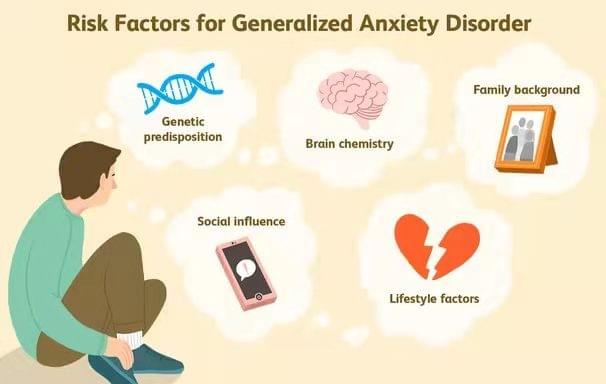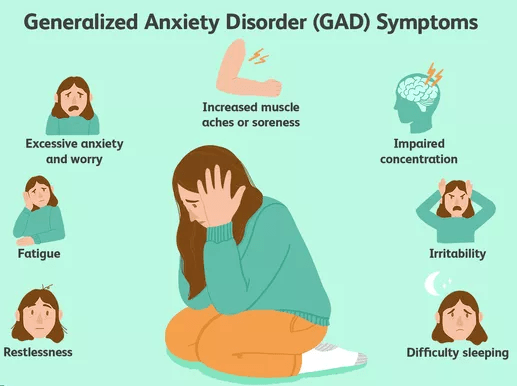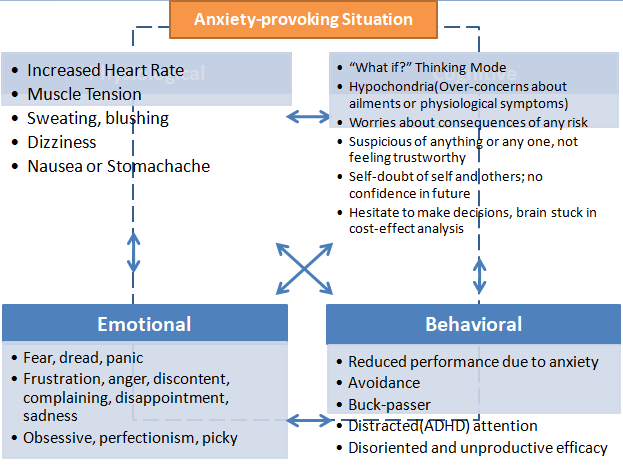

- Home
- Mental Attributes
- Insecurity
- Delusional Fears|Overdefensive
- Lack of Self-Esteem
- Denial of Reality|Egocentric
- Psychotherapy
- Psychodynamic|Psychoanalysis
- CBT|Cognitive Behavioral
- Watson Behaviorism
- Gestalt Therapy
- Jungian Analysis
- Freud's Psychoanalysis
- Humanistic Psychology
- Evolutionary Psychology
- Psychokinetic Act Psychology
- PsycheTruth
- Dynamic Blog
- Service
- Healing Bench
- Counseling
- About Us

What is Anxiety in general?
Psychological& Physiological State characterized by Somatic, Emotional, Cognitive &Behavioral components

Multiple Risk Factors at play causing GAD
5 Common Endexoteric Contributing Factors
- Genetics
- Genetic Expression:First degree relatives as parent, sibling or child of sBrain Structureomeone with GAD is more likely to develop mood and anxiety disorders triggered by certain environmental factors
- Gender: Women are more prone(twice as likely) to be anxiety disorders in general
- Age:GAD is developed gradually, with the greatest risk between childhood and middle age, although the condition typically begins around 30 y-o
- Brain Structure
- Amygdala: as part of limbic system involved in the automatic fear response, as well as in the integration of memory and emotion
- Patients with GAD: Heightened Activity within amygdala impacting inaccurate interpretations of social behaviors, which one may perceive a delusional social cue or interaction as threatening when it is not actually threatening.
- Gray Matter: A larger/increased volume of gray matter in the 'right putamen' of people with GAD's brain was positively correlated with 'childhood maltreatment'
- Life Experiences
- Experienced Trauma: Trauma in childhood such as 'physical and mental abuse', neglect(eg. left-behind children), death of a loved one, abandonment(eg. orphan, foundin), divorce or isolation(eg. confinement),etc, will leave them feeling uncertain, humiliated or apprehensive to trust others. Such negative mental experience continues performing as 'conditional reflex' as they grow up, and have them difficulty fairly interpreting threats. Any life events that result in feelings of loss, humiliation, entrapment and danger seem harmless to most, yet cause sense of emotionally dangerous and anxiety-producing to develop and lead to onset of GAD.
- Learned Behavior: Behavioral scientists believe anxiety is a learned behavior since early social learning experience, generally from a parent or caregiver who demonstrate anxious or less effective methods of stress mgmt. Children may tend to mirror that same anxious behaviour, which can influence the development of long-lasting anxiety.
- Societal Factors:
- Use of social media in excess, rather than social contact in real life(i.e.those 'Homebody' or 'the Autistics') can cause people at times missing essential non-verbal cues in communication such as 'facial expressions, body language and tone', which typically trigger brain to function less effective in accurately interpreting social cues and interactions, eventually leaving them to potentially feel a heightened sense of danger or rejection, particularly loneliness, rejection, abandonment or humiliation.
- Lifestyle Factors
- Daily Use of Addictive Substance: Excessive quantities of consumption dependence on caffeine sources such as coffee, tea, soda and energy drinks to motivate one's productivity can cause a rising sensation of worry, restless or nervousness, contributing to the development of anxiety
- Relationships: Dangerous and fearful experiences within intimate relationships can influence the development of anxiety. And women are twice as likely as men to develop GAD, specifically by research two factors as in 'being afraid of or humiliated by a current partner or ex-partner.
Job Stress: Can be a great source of stress and become a trigger in the development of anxiety.
Ⅰ. Some employers expect and push extraordinarily high KPI and productivity that can threaten one's sense of
employment security;
Ⅱ. When looking for work, you may sense the instinctual pressure from other applicants who seem highly qualified and
sophisticated, causing you to feel the stress related to your ability to be afraid of being left behind or FOMO;
Ⅲ. The loss of a job can be a significant source/trigger of heightened anxiety
In a nutshell, regardless of any source or anxiety-related conditions to onset with, the potential for developing anxiety into GAD is incrementally INCREASED during periods of severe and prolonged stress.

Symptoms &Diagnosis of GAD
A set of Symptom Criteria Outlined in DSM-5 for Mental Health Professionals for Diagnosing GAD reference
- The presence of Excessive Anxiety and Worry about a variety of topics, events, or activities, at least 6mths: even when there is no specific threat present or in a manner disproportionate to the actual risk.
- The worry is experienced as very challenging to control, easily shift from one topic to another: A high percentage of one's waking hours worrying about something; the worry may be accompanied by reassurance-seeking from others.
- The anxiety and worry are accompanied by at least three(for adults) or one(for children) of the following physical or cognitive symptoms as below:
- Edginess or Restlessness
- Tiring easily; more fatigued than usual
- Impaired Concentration or feeling as though out of mind(or goes blank, hollow heart)
- Irritability(which may or may not be observable to others)
- Increased Muscle Aches or Soreness
- Difficulty Sleeping/Somnipathy(trouble falling asleep or staying asleep, restlessness at night, or unsatisfying sleep)
- Sweating
- Nausea
- Diarrhea


Anxiety -"Dizziness of Freedom".
A primal urge/call from 'one of the Archetypes of Anthropic(mortal)Collective Unconsciousness: Pursuit of FREEDOM/Life Mission to Break-through Self Potential Potency(Latent Energy)', that results in adequate motivated 'stress response', leading to the unfolding of proper vitality and life force, as we all know is namely 'Self-Actualization'
In 1844, Soren Kierkegaard wrote of anxiety as being the 'dizziness of freedom', the dizzying effect of looking into the boundlessness of one's own possibilities. Without anxiety, there would be no possibility of exploring one's potential beyond one's cognition &perception and therefore no capacity to grow and develop as a human being.
Anxiety SWOT Analysis
- Individual Causes
- Genetic Factors
- Environmental Factors
- Gender
- Triggers
- Exposure to situations in which one's EGO is/may be harmed
- One's 'View of World' incompatible with current actual situation - inability to peruse personal reassessment &values
- Threats &Harm
- Physical Harm - Sympathetic Nerve Hyperactivity(HPA Axis negative feedback)
- Psychological Harm - UNCONSCIOUS conflicts between id impulses' threats(sexual or aggressive types) and constraints imposed by EGO & SuperEGO, in application of Defense Mechanism to cope, causing frustration and hurting self-esteem in reality
- Benefits
Pressure/Drive to perform beyond one's capability | Digging one's potential beyond one's own
knowledge and cognition
- Consequences/Results
Fight-Flight stress-response HPA axis bio-reactions
Often do not deal with the conflicting issues but ignore, avoid or dump the problems, potentially
believing "their anxiety as a result of being threatened by 'painful stimuli' which can only be controlled
by avoidance".
Manifestation of Intensified Anxiety
- Social Anxiety Disorder
- Phobia
- OCD(Obsessive Compulsive Disorder)
- PTSD(Post-traumatic Stress Disorder)
- Depression
- Bipolar or MPD(Multiple Personality Disorder)
Anxiety 'Test'
- Scenario: student takes an exam with 'Carrot &Stick Mechanism'
- Criteria: Fear of Negative Evaluation
- Why 'proper stimulation' is productive?
- 'OPTIMAL level of Stimulation' is necessary for 'Maximl Performance', like exam, task deadline, work OKRs, game, competition, etc
- However, when the anxiety or 'level of stimulation' EXCEEDS that OPTIMUM, results in 'a DECLINE in Performance'
- What miscognition gives rise to Anxiety under optimal level of stimulation?
- Association of grades with personal worth
- Imagined fear of being eliminated or distained by the leader or authority; fear of alienation from parents or friends
- Ego is threatened by id impulses that it cannot control------->Delusion of feeling inferior, embarrassed, ashamed, guilty invoked by unconscious id whose vanity desires originated from 'omnipotent narcissism' are suppressed by superego
- Discomforted sense of feeling helpless, losing control of time and direction originated from one of the subconscious archetypes from id impulses
Anxiety Coping &Management
- Key Principle: Degree of Anxiety depends on our 'Level of Control'
- Combination of Both Methods as below:
- Problem-based: Issues-Realization by appraising anxiety-evoked situation and deal with Prob-Solving skills
- Emotion-based: Attention transfer, breathing or mindfulness guidance(as if perceiving problems as friendly and soluble) to reduce the intensity feelings prior to dealing with the problem
- Treatment Alternatives
- CBT - Cognitive Behavioral Therapy
- PAM - Parental Anxiety Management
- Hypnotherapy/Hypnosis
- Decrease in caffeine intake
About Us
Our Mission
We're Hiring!
Resources
Tutorials
Brand Assets
Contact Us
321-555-5555
info@figapps.co
© 2019




